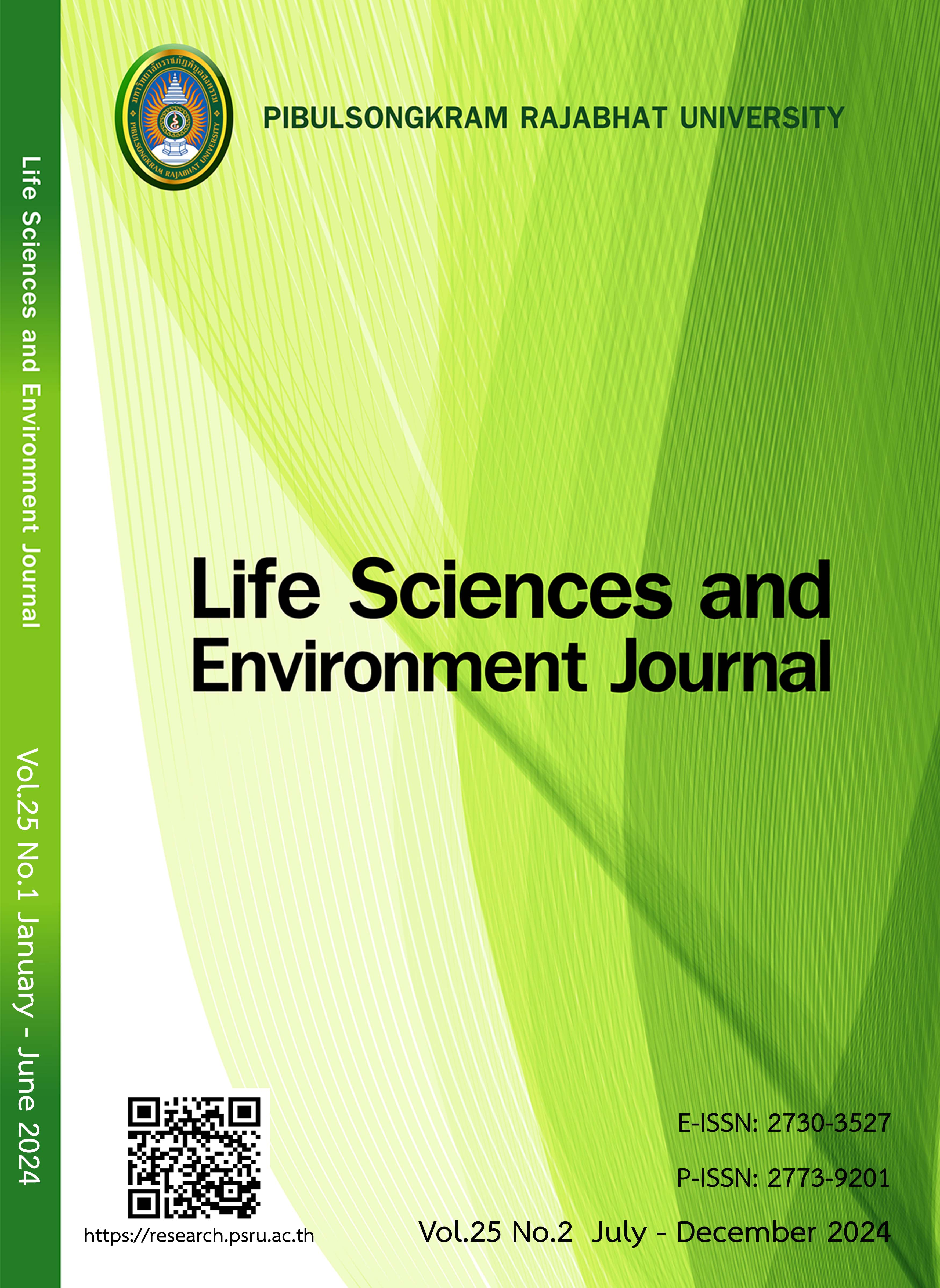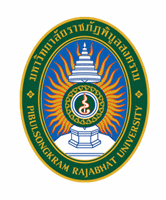PHYTOCHEMICAL CONTENTS AND ANTIOXIDANT ACTIVITIES OF PASTEURIZED CITRUS AURANTIUM L. (BITTER ORANGE) JUICE
DOI:
https://doi.org/10.14456/lsej.2024.24Keywords:
citrus aurantium l., phytochemical, antioxidant activityAbstract
Bitter orange (Citrus aurantium L.) is an ancient therapeutic plant. Normally, peels of bitter orange fruit are used as a food ingredient in Thailand, leaving the pulp as waste. This research aimed to develop pasteurized bitter orange juice by studying the effect of dilution and pH on phytochemical contents and antioxidant activity. The bitter orange juice concentrations were prepared at 50, 75, and 100% w/v by DI water and adjusting pH at 2.5, 3.0, and 3.5 by using potassium chloride. The bitter orange juices were pasteurized at 70°C for 5 min. The result showed that 100% w/v pasteurized bitter orange had the highest contents of titratable acidity, ascorbic acid, and total phenolic, approximately 41.60 to 48.67 g/L, 31.26 to 32.26 mg/100 mL, and 54.80 to 57.08 mg GAE/100 mL of juice, respectively when compared to other concentrations. Likewise, antioxidant activity results (DPPH, ABTS, and FRAP) of 100% w/v pasteurized bitter orange juice gave the highest values about 390.58 to 458.15 GAE/100 mL of sample 546.20 to 503.33 µg Trolox/100 mL of sample, and 525.55 to 422.48 µg Trolox/100 mL of sample.
The pH variation did not affect the alteration of phytochemical and antioxidant activities in 100% w/v pasteurized bitter orange (p<0.05). Conversely, pH adjusting of 50 and 75% w/v pasteurized bitter oranges showed significant differences in the ascorbic acid and total phenolic contents (p≤0.05) but non-significant differences in citric and ascorbic acid contents. All pasteurized bitter orange juice microbiological resulted showed that the total coliform counts was <2.2 MPN/ 100 mL of sample and yeast and molds were not detected initially and after 5 days of storage, confirming the safety of the pasteurization process.
References
Aadil RM, Madni GM, Roobab U, ur Rahman U, Zeng X. 1-Quality Control in Beverage Production: An Overview. In Grumezescu AM, Holban AM. (Eds.), Quality Control in the Beverage Industry. Cambridge: Academic Press; 2019:1-38.
Ağçam E, Akyıldız A, Dündar B. Chapter 17 - Thermal Pasteurization and Microbial Inactivation of Fruit Juices. In Rajauria G, Tiwari BK. (Eds.), Fruit Juices: Extraction, Composition, Quality and Analysis. Cambridge: Academic Press; 2018:309-339.
Al-Khalid T, El-Naas MH. Aerobic Biodegradation of Phenols: A Comprehensive Review. Critical Reviews in Environmental Science and Technology 2012;42:1631-1690.
Arunrung-aree A, Otaka K, Sisot P. Chemistry Laboratory II. Bangkok: Ramkhamhaeng University Press; 2005.
Bacteriological Analytical Manual. (2001). BAM Chapter 18: Yeasts, Molds and Mycotoxins. Available at: https://www.fda.gov/food/laboratory-methods-food/bam-chapter-18-yeasts-molds-and-mycotoxins. Accessed April 8, 2024.
Bacteriological Analytical Manual. (2020). BAM Chapter 4: Enumeration of Escherichia coli and the Coliform Bacteria. Available at: https://www.fda.gov/food/laboratory-methods-food/bam-chapter-4-enumeration-escherichia-coli-and-coliform-bacteria. Accessed April 8, 2024.
Benayad O, Bouhrim M, Tiji S, Kharchoufa L, Addi M, Drouet S, Hano C, et al. Phytochemical Profile, α-Glucosidase, and α-Amylase Inhibition Potential and Toxicity Evaluation of Extracts from Citrus aurantinum (L) Peel, a Valuable By-Product from Northeastern Morocco. Biomolecules 2021;11(11):1555.
Brossard N, Fellenberg MA, Ibáñez RA, Muñoz MF, Osorio F, Salazar FN, Vargas-Bello-Pérez E, et al. Influence of milk pH on the chemical, physical and sensory properties of a milk-based alcoholic beverage. Journal of Dairy Research 2019;86(2):248-251.
Cairns AM, Watson M, Creanor SL, Foye RH. The pH and titratable acidity of a range of diluting drinks and their potential effect on dental erosion. Journal of Dentistry 2002;30(7-8):313-317.
Desseva I, Stoyanova M, Petkova N, Mihaylova D. Red Beetroot Juice Phytochemicals Bioaccessibility: an In Vitro Approach. Polish Journal of Food and Nutrition Sciences 2020;70(1):45-53.
Divya PJ, Jamuna P, Jyothi LA. Antioxidant properties of fresh and processed Citrus aurantium fruit. Cogent Food & Agriculture 2016;2:1184119.
Erkmen O, Bozoglu TF. Food Microbiology: Principles into Practice, 2 Volume Set. New Jersey, NJ: Wiley; 2016.
Fellows PJ. Food Processing Technology. 4th ed. Cambridge: Woodhead Publishing; 2017.
Friedman M, Jurgens HS. Effect of pH on the Stability of Plant Phenolic Compounds. Journal of Agricultural and Food Chemistry 2000;48:2101-2110.
Guo H, Zheng Y, Wu D, Du X, Gao H, Ayyash M, Zeng DG, et al. Quality evaluation of citrus varieties based on phytochemical profiles and nutritional properties. Frontiers in Nutrition 2023;10:1165841.
Haraoui N, Allem R, Chaouche TM, Belouazni A. In-vitro Antioxidant and Antimicrobial Activities of Some Varieties Citrus Grown in Algeria. Advances in Traditional Medicine 2020;20:23-34.
Karabıyıklı Ş, Değirmenci H, Karapınar M. Inhibitory Effect of Sour Orange (Citrus aurantium) Juice on Salmonella Typhimurium and Listeria monocytogenes. LWT - Food Science and Technology 2014;55(2):421-425.
Kowalska M, Konopska J, Feszterová M, Zbikowska A, Kowalska B. Quality Assessment of Natural Juices and Consumer Preferences in the Range of Citrus Fruit Juices. Applied Sciences 2023;13:765.
Lualamai K. "Citrus aurantium var. aurantium" is a rare ancient medicinal plant used for cooking delicious food. Available at: https://www.technologychaoban.com/agriculturaltechnology/ article_71253#google_vignette. Accessed April 8, 2024.
Maksoud S, Abdel-Massih RM, Rajha HN, Louka N, Chemat F, Barba FJ, Debs E. Citrus aurantium L. Active Constituents, Biological Effects and Extraction Methods. An Updated Review. Molecules 2021;26:5832.
Memariani Z, Gorji N, Moeini R, Farzaei MH. Chapter Two - Traditional uses. In Seyed Mohammad Nabavi SM, Suntar I, Barreca D, Khan H. (Eds.), Phytonutrients in Food. Cambridge: Woodhead Publishing; 2020:23-66.
Mohammed BB, Najim, SY, Shatti ZO, Jasim EI, Dari WA. Comparative study of antibacterial activity between the Citrus Limon (Lemon) & Citrus Aurantium (Bitter Orange) Extracts on Pseudomonas Aeruginosa Isolates from Burns Infections. Mintage Journal of Pharmaceutical & Medical Sciences 2018;7(1):20-23.
Overstreet K, Roy, Heli J. Bacteria (Lesson 22). Available at: https://www.lsuagcenter.com/topics/ food_health/education_resources/eatsmart/lessons/bacteria-lesson-22. Accessed April 8, 2024.
Petruzzi L, Campaniello D, Speranza B, Rosaria C, Sinigaglia M, Bevilacqua A. Thermal Treatments for Fruit and Vegetable Juices and Beverages: A Literature Overview. Comprehensive Reviews in Food Science and Food Safety 2017:668-691.
Rimlamduan T, Wechsuwan P, Sompeerapun O, Romsomsa N, Kachenpukdee N, Thaiwong N. Effect of temperature on drying rate, phytochemicals and antioxidant activities in Vitex glabrata R. BR. fruit. Life Sciences and Environment Journal 2024;24(1):113-126.
Saeeduddin M, Abid M, Jabbar S, Wu T, Yuan Q, Riaz A, Hu B, Zhou L, Zeng X. Nutritional, microbial and physicochemical changes in pear juice under ultrasound and commercial pasteurization during storage. Journal of Food Processing and Preservation 2017;e13237.
Schieber A. Reactions of Quinones-Mechanisms, Structures, and Prospects for Food Research. Journal of Agricultural and Food Chemistry. 2018;66(50):13051-13055.
Singh R, Rathod G, Meletharayil GH, Kapoor R, Sankarlal VM, Amamcharla JK. Invited review: Shelf-stable dairy protein beverages—Scientific and technological aspects. Journal of Dairy Science 2022;105(12):9327-9346.
Stohs SJ. Safety, Efficacy, and Mechanistic Studies Regarding Citrus aurantium (Bitter Orange) Extract and -Synephrine. Phytotherapy Research 2017;31:1463–1474.
Suntar I, Khan H, Patel S, Celano R, Rastrelli L. An Overview on Citrus aurantium L.: Its Functions as Food Ingredient and Therapeutic Agent. Oxidative Medicine and Cellular Longevity 2018;7864269.
Sustainable Agriculture Foundation Thailand. Citrus aurantium L. Available at: https://sathai.org/?p= 2152. Accessed April 8, 2024.
Wu RA, Yuk H, Liu D, Ding T. Recent advances in understanding the effect of acid-adaptation on the cross-protection to food-related stress of common foodborne pathogens. Critical Reviews in Food Science and Nutrition 2022;62(26):7336-7353.
Xutian S, Tai S, Yuan CS. Handbook of Traditional Chinese Medicine. China: World Science Publishers; 2014.
Yin X, Chen K, Cheng H, Chen X, Feng S, Song Y, Liang L. Chemical Stability of Ascorbic Acid Integrated into Commercial Products: A Review on Bioactivity and Delivery Technology. Antioxidants 2022;11(1):153.
Yu L, Wu Y, Liu D, Sheng Z, Liu J, Chen H, Feng W. The kinetic behavior of antioxidant activity and the stability of aqueous and organic polyphenol extracts from navel orange peel. Food Science and Technology 2022;42:e90621.
Zeb A. Concept, mechanism, and applications of phenolic antioxidants in foods. Journal of Food Biochemistry 2020;44(9):e13394.
Downloads
Published
How to Cite
Issue
Section
License
Copyright (c) 2024 Life Sciences and Environment Journal

This work is licensed under a Creative Commons Attribution-NonCommercial-NoDerivatives 4.0 International License.
Each article is copyrighted © by its author(s) and is published under license from the author(s).










